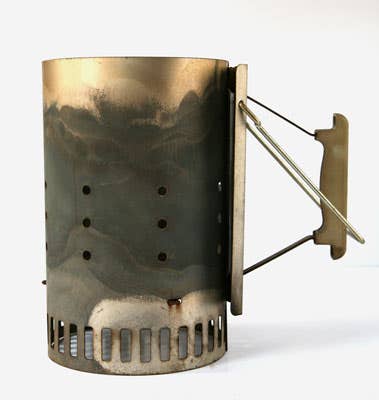
Charcoal Chimney Starter
Let's face it, masters of the grill: most of us have been humbled by a pile of charcoal that failed to light. As a child of the 1980s, I once thought that all backyard burgers were supposed to have that telltale essence of lighter fluid (no offense, Dad); it seemed that accessing the help of an accelerant was the only way to get that big pyramid of briquettes to ignite.
Enter the charcoal chimney starter. Invented in the 1960s, this tool is so indispensable that we're surprised more cooks don't use it. For those of you who might be fearful of such a useful device, we've found a handy video that demonstrates how you can get it going. The chimney quickly ignites a pile of briquettes or our favorite fuel—lump charcoal—and reduces it to a glowing pile of red-hot coals in about 20 minutes. The chimney operates on the principle known as, well, the chimney effect. The heat from the fire starter, in this case crumpled newspaper placed in the bottom chamber of the cylinder, moves upward through the chimney, lowering the pressure and sucking in oxygen through the chimney's vents. "This rapidly rising heat stack, combined with a continuous supply of new oxygen, creates, in essence, a miniature blast furnace," says Duane Fields, the 38-year-old author of the blog the BBQ Report.
Practical, cheap, and efficient, the Weber Rapid Fire model holds about six quarts of charcoal, enough fuel to grill 12 burgers over direct heat in a kettle grill. We also use it for slow and low pit-style cooking when we need a continuous supply of coals ready at the side. Bring it on, charcoal. —Hunter Lewis, SAVEUR
Keep Reading
Continue to Next Story










